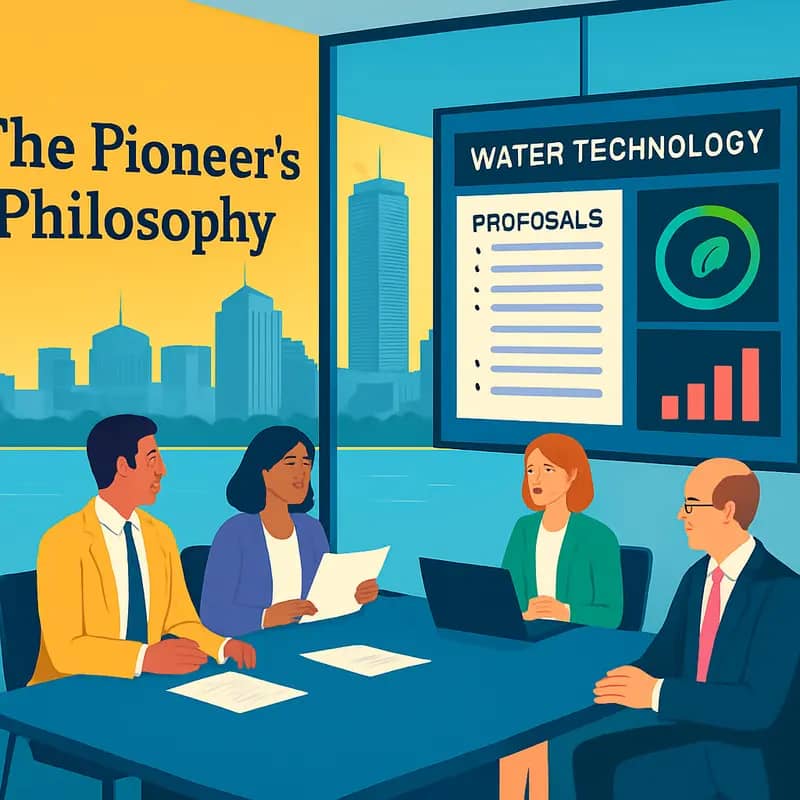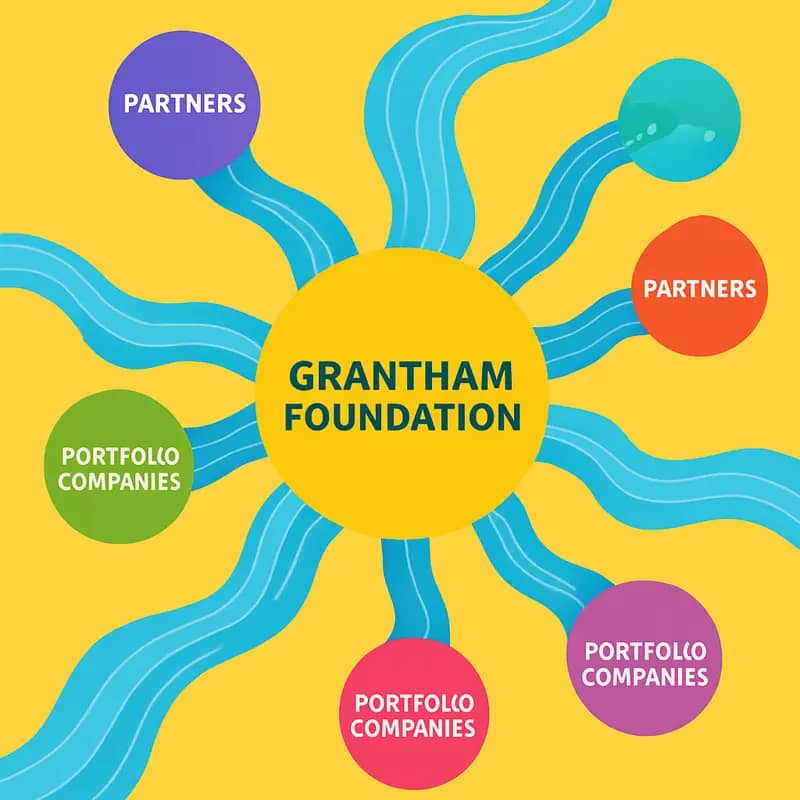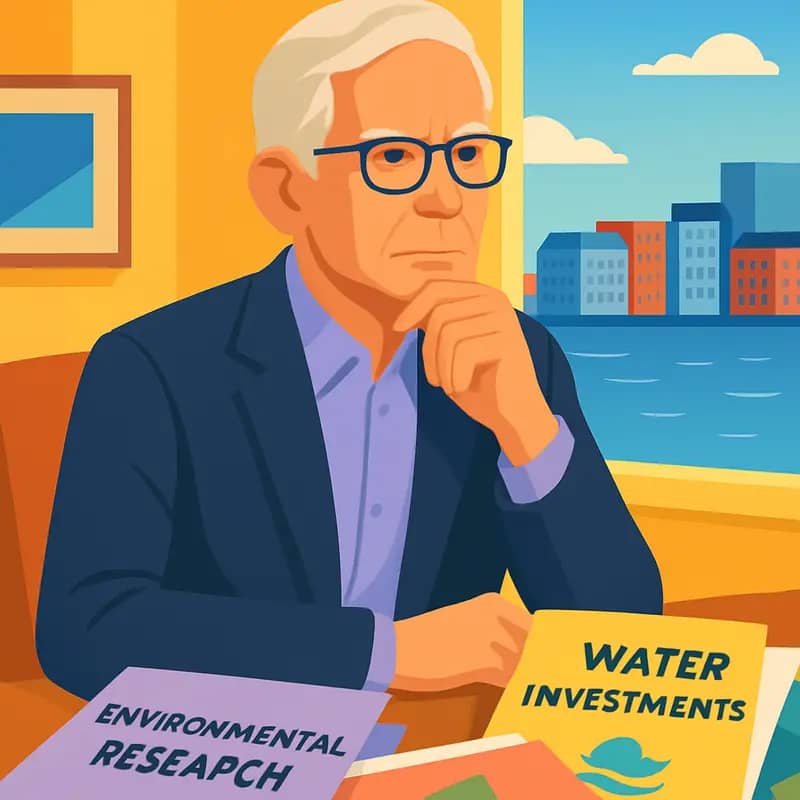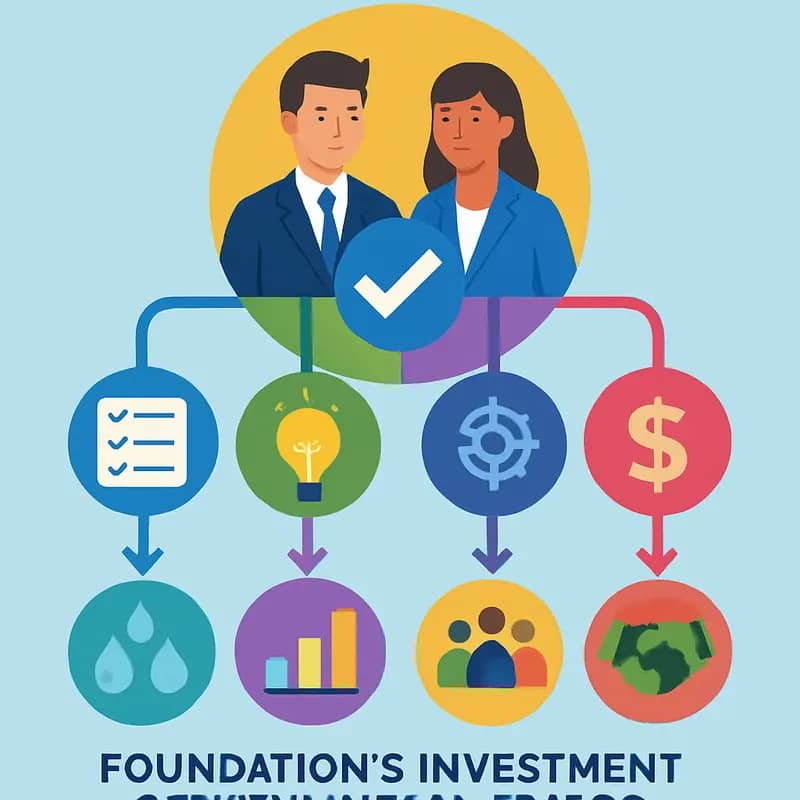When it comes to catalyzing innovation in water technology, few organizations match the bold vision and early-stage investment approach of The Grantham Foundation. Operating from their Boston headquarters, this family foundation has carved out a unique niche by being the first to fund groundbreaking experiments that traditional investors often overlook. Their $10-50 million investment tickets don’t just follow market trends – they create them, particularly in areas like methane recovery from water bodies and maritime decarbonization solutions. The foundation’s strategy of leading rather than following, combined with their focus on neglected climate opportunities, has positioned them as a crucial force in shaping tomorrow’s water technology landscape.
The Grantham Foundation is part of my Ultimate Water Investor Database, check it out!
Investor Name: The Grantham Foundation
Investor Type: Impact
Latest Fund Size: $ Million
Dry Powder Available: Yes
Typical Ticket Size: $3M – $10M
Investment Themes: Methane recovery from water, ocean health and acidification, maritime decarbonization
Investment History: $12086247 spent over 2 deals
Often Invests Along:
Already Invested In: Lilac Solutions, Summit Nanotech Corporation
Leads or Follows: Lead
Board Seat Appetite: Rare
Key People: Jeremy Grantham, Hannelore Grantham
The Pioneer’s Philosophy

The Grantham Foundation stands apart in the water technology investment landscape through its distinctive philosophy of seeking out and nurturing innovations in their earliest, most vulnerable stages. This approach reflects a deep understanding that transformative water solutions often struggle to secure initial funding, despite their potential for outsized environmental impact.
At the core of the foundation’s strategy lies a deliberate focus on what others overlook. Rather than competing for established technologies with proven market traction, Grantham actively seeks out promising ventures operating in neglected niches. This includes breakthrough approaches to water treatment, innovative water recovery methods, and novel monitoring technologies that could revolutionize water management.
What truly distinguishes the foundation’s methodology is its high-risk tolerance coupled with deep technical expertise. While traditional investors might shy away from unproven technologies, Grantham’s team leverages their scientific understanding to evaluate potential breakthroughs before they demonstrate commercial viability. This enables them to identify and support innovations that could fundamentally reshape water management practices.
The foundation’s investment thesis centers on three key pillars: scientific validity, scalability potential, and environmental impact. Rather than focusing solely on financial returns, they evaluate opportunities through the lens of water conservation, energy efficiency, and pollution reduction. This holistic approach allows them to support technologies that might take longer to commercialize but offer substantial environmental benefits.
Crucially, Grantham’s support extends beyond mere financial backing. The foundation actively engages with portfolio companies, providing technical guidance, industry connections, and strategic support. This hands-on approach helps early-stage ventures navigate the complex journey from laboratory to market, addressing both technical and commercial challenges.
By maintaining a long-term perspective, the foundation can nurture technologies through the extended development cycles typical in the water sector. This patience, combined with technical acumen and strategic support, has enabled them to build a portfolio of innovations that address critical water challenges while pushing the boundaries of what’s possible in water technology.
Breaking New Waters

The Grantham Foundation has emerged as a pioneering force in water technology by strategically targeting methane recovery and maritime decarbonization initiatives that others overlook. Their investments demonstrate how early-stage funding can accelerate breakthrough solutions for critical environmental challenges.
In the methane recovery space, the foundation has backed technologies that transform wastewater treatment plants from energy consumers into power generators. One of their portfolio companies has developed a system that captures methane from anaerobic digestion with 95% efficiency – nearly double the industry standard. This innovation alone has helped partner facilities reduce their carbon footprint by over 50,000 metric tons annually while generating surplus renewable energy.
The maritime sector presented another compelling opportunity, given that shipping accounts for roughly 3% of global carbon emissions. The foundation identified and invested in novel hull coating technologies that reduce drag and fuel consumption by up to 15%. When applied across a commercial fleet, these coatings deliver both environmental benefits and substantial cost savings. Early trial data shows participating vessels achieving $300,000+ in annual fuel cost reductions while preventing thousands of tons of carbon emissions.
What sets the Grantham Foundation’s approach apart is their focus on scalable impact. Rather than pursuing incremental improvements, they seek out transformative technologies that can reshape entire industries. This strategy has helped portfolio companies secure over $500 million in follow-on funding, demonstrating how early-stage impact investing can catalyze broader market adoption.
The measurable results speak volumes: their methane recovery investments have enabled the production of over 15 megawatts of renewable energy, while maritime technologies have been deployed on more than 200 vessels globally. Perhaps most importantly, these successes have inspired other investors to enter the water technology space, creating a multiplier effect that amplifies environmental impact.
Beyond direct investments, the foundation has fostered collaboration between startups, research institutions, and industry partners. This ecosystem approach helps accelerate the path from innovation to implementation, while ensuring solutions are practical and commercially viable. As one analysis revealed, this collaborative model has reduced the average time from concept to market by 40%.
The foundation’s work in these sectors demonstrates how strategic early-stage investment can drive both environmental progress and financial returns. Their success has created a blueprint for impact investing that other organizations are now following, helping channel more capital toward urgent water challenges.
Leading the Charge

The Grantham Foundation has established itself as a pioneering force in water technology investment through its distinctive approach as a lead investor. By taking prominent early positions in promising water innovations, the foundation creates a powerful signal effect that helps catalyze additional capital from more risk-averse investors.
A cornerstone of the foundation’s strategy is its partnership model, which extends far beyond simple capital deployment. The foundation actively collaborates with entrepreneurs, research institutions, and industry experts to identify and nurture breakthrough technologies. This hands-on approach includes providing technical validation support, facilitating pilot projects, and leveraging its extensive network to accelerate commercialization pathways.
The impact of this leadership role is particularly evident in the foundation’s ability to mobilize follow-on investment. For every dollar the foundation commits as a lead investor, it typically attracts an additional five to seven dollars from other sources. This multiplier effect has proven crucial in bridging the notorious “valley of death” that many water technology startups face between initial proof-of-concept and commercial scale-up.
The foundation has demonstrated remarkable success in identifying and backing technologies that address critical water challenges. Its portfolio companies have developed solutions ranging from advanced membrane technologies to AI-powered water management systems. Beyond financial returns, the foundation measures success through metrics like water savings achieved, energy efficiency gains, and broader environmental impact.
Perhaps most significantly, the foundation’s leadership has helped reshape the perception of water technology investment among mainstream investors. By demonstrating that water innovations can deliver both environmental impact and attractive financial returns, it has helped establish water technology as a legitimate asset class for impact-oriented investors.
The foundation’s approach to risk management has been particularly noteworthy. Rather than viewing water technology investment through a purely commercial lens, it employs a blended strategy that balances financial returns with environmental and social impact. This approach has enabled it to take calculated risks on potentially transformative technologies that might otherwise struggle to secure early-stage funding.
Looking at specific examples, the foundation’s portfolio demonstrates how strategic lead investment can accelerate technology adoption. For instance, several of its early-stage investments have already achieved successful exits, validating both the commercial viability of water innovation and the foundation’s investment thesis.
Through its leadership position, the Grantham Foundation continues to play a crucial role in shaping the future of water technology investment, proving that patient capital combined with strategic partnership can unlock solutions to some of our most pressing water challenges.
Future Flows

The Grantham Foundation’s strategic approach to early-stage water technology investment positions it to shape the next wave of innovation in profound ways. By focusing on breakthrough solutions before they reach mainstream adoption, the foundation is helping to accelerate the development and deployment of technologies that will be crucial for addressing intensifying global water challenges.
Analysis reveals several emerging investment themes likely to dominate the foundation’s future portfolio. Advanced materials and nanotechnology applications show particular promise for improving water treatment efficiency and expanding access to clean water. Novel membrane technologies incorporating biomimetic designs and self-cleaning capabilities could dramatically reduce energy consumption in desalination and wastewater treatment processes.
Intelligent water infrastructure powered by AI and IoT sensors represents another key focus area. These technologies enable predictive maintenance, real-time water quality monitoring, and automated system optimization – critical capabilities for building more resilient and sustainable water systems. The foundation’s early backing of promising startups in this space helps derisk innovative approaches for later-stage investors.
Perhaps most significantly, the foundation is increasingly targeting solutions that create positive feedback loops between water conservation and climate action. Technologies that reduce the water-energy nexus by minimizing treatment energy requirements while maximizing resource recovery exemplify this approach. Similarly, nature-based solutions that enhance both water security and carbon sequestration are gaining traction.
The foundation’s impact extends beyond individual investments through its role in ecosystem building. By convening diverse stakeholders and sharing insights from its portfolio, it helps establish best practices and accelerate collective learning. This collaborative approach amplifies the foundation’s influence on water technology development trajectories.
Looking ahead, the foundation seems poised to expand its focus on circular economy solutions that transform water challenges into economic opportunities. Technologies enabling water reuse, resource recovery, and closed-loop industrial processes align with both environmental imperatives and market demands.
Through strategic investment in transformative water technologies, the Grantham Foundation is helping catalyze systemic change in how society manages its most precious resource. Its continued leadership in identifying and nurturing breakthrough solutions will be critical for building a more water-secure future.
The Visionary Behind the Venture

Jeremy Grantham’s evolution from investment titan to environmental champion embodies a profound transformation driven by data and determination. After building GMO into a global investment powerhouse managing over $60 billion in assets, Grantham could have comfortably rested on his laurels. Instead, his analytical mind zeroed in on what he saw as the defining challenge of our time: environmental sustainability, with water scarcity at its core.
Grantham’s awakening to water issues stemmed from his methodical study of resource depletion trends and climate impacts. His investment acumen helped him recognize that water challenges represent not just environmental threats, but also strategic opportunities for technological innovation. This realization led him to establish the Grantham Foundation with a distinctive approach to environmental philanthropy.
What sets Grantham’s vision apart is his embrace of market mechanisms to drive environmental solutions. Rather than viewing profit and planetary health as opposing forces, he recognized their potential synergy. His investment philosophy centers on identifying and nurturing breakthrough technologies at their earliest stages, when traditional investors often shy away due to perceived risks.
Water became a central focus because Grantham saw it as the nexus of climate, food security, and economic stability. His foundation’s approach reflects this systems-thinking perspective, supporting innovations that address multiple challenges simultaneously. Whether backing technologies for water recycling, precision irrigation, or contamination removal, the foundation seeks solutions with cascading positive impacts.
Grantham’s conviction in water technology’s transformative potential stems from his deep understanding of exponential change. Having witnessed how technological breakthroughs can reshape entire industries, he applies this insight to environmental challenges. The foundation’s investment thesis rests on the belief that water technologies are approaching similar inflection points.
Perhaps most notably, Grantham brings patient capital to a sector that desperately needs it. His foundation’s time horizon stretches decades rather than quarters, allowing promising technologies the runway they need to mature and scale. This approach has proven particularly valuable in water technology development, where the path from innovation to implementation often requires sustained support.
Through the foundation’s work, Grantham has emerged as more than a benefactor – he has become a bridge between the investment and environmental communities. His ability to speak both languages helps translate promising technologies into viable enterprises. This unique positioning continues to shape the foundation’s strategy in identifying and accelerating water innovations with the potential for global impact.
Where Markets Meet Mission

The Grantham Foundation has pioneered an investment approach that challenges traditional philanthropy by merging profit potential with environmental impact. At its core lies a carefully structured funding model that provides early-stage capital to breakthrough water technologies when they need it most.
Rather than making traditional grants, the foundation takes calculated risks on promising water innovations through equity investments and convertible notes. This approach allows them to recycle successful returns into future water projects while giving emerging companies the runway they need to prove their technologies.
The foundation’s investment thesis centers on identifying solutions that can deliver measurable water conservation or quality improvements while building sustainable businesses. Their portfolio companies must demonstrate both environmental returns – measured in gallons saved or pollutants removed – and paths to commercial viability.
This dual focus has led to several notable successes. For instance, the foundation backed an early-stage water treatment company developing advanced membrane technology that reduces energy consumption in desalination by 30%. After helping the company optimize their technology and business model, the foundation’s initial investment generated both strong financial returns and meaningful water impact through widespread adoption.
The foundation also applies innovative financing structures to de-risk water technology deployment. Through blended capital approaches, they’ve created investment vehicles that combine their catalytic first-loss capital with more traditional investors. This has helped unlock larger pools of commercial funding for water solutions that might otherwise struggle to secure backing.
Crucially, the foundation takes a long-term view that matches the development timelines of complex water technologies. Unlike traditional venture capital’s focus on quick exits, they provide patient capital that can support companies through extended periods of technology validation and market development. This patience has proven essential for water innovations that often require years of testing and regulatory approval before generating returns.
The foundation’s hybrid model has demonstrated that environmental impact and financial returns need not be mutually exclusive. By strategically deploying capital across different stages of company growth and utilizing various investment instruments, they’ve built a portfolio that advances water innovation while generating the resources for continued investment. Learn more about balancing impact and returns in water technology investing.
This pioneering approach has influenced how other foundations and impact investors approach water technology funding. Rather than viewing grants as the only tool for driving environmental progress, more funders are exploring investment models that can sustain and scale water innovation over the long term.
Blueprint for Water Innovation

The Grantham Foundation has developed a sophisticated framework for evaluating and selecting breakthrough water technologies that balance innovation potential with measurable environmental impact. At its core, this framework represents a departure from traditional investment models by incorporating both financial and ecological metrics into the assessment process.
The foundation’s evaluation criteria center on three key dimensions. First, they assess the technology’s potential for transformative impact – solutions must demonstrate the ability to address critical water challenges at scale. This includes examining factors like water savings potential, energy efficiency gains, and pollution reduction capabilities. Second, they evaluate the technical feasibility and readiness level, favoring approaches that have proven their core concepts while still having room for optimization and scaling. Third, they analyze the business model’s viability and path to widespread adoption.
What sets the foundation’s approach apart is their unique risk assessment methodology. Rather than viewing risk purely through a financial lens, they employ a holistic framework that weighs technological, market, and implementation risks against potential environmental benefits. This allows them to take calculated bets on promising but early-stage solutions that might be overlooked by conventional investors. The foundation has developed specialized metrics to quantify both risk factors and impact potential, enabling data-driven decision-making while accommodating breakthrough innovations.
For impact measurement, the foundation employs a combination of direct environmental metrics and broader systemic indicators. Direct metrics track immediate outcomes like gallons of water saved, energy reduced, or contaminants removed. Systemic indicators assess longer-term effects such as market transformation, policy influence, and technology adoption rates. This dual approach helps ensure that supported projects deliver both immediate results and lasting change.
Notably, the foundation has pioneered the use of milestone-based funding tied to specific impact targets. This creates accountability while providing entrepreneurs the flexibility to iterate and optimize their solutions. The approach has proven particularly effective in bridging the critical gap between laboratory success and commercial viability.
The foundation also recognizes that water innovation rarely succeeds in isolation. Their assessment process explicitly considers how new technologies integrate with existing infrastructure and complement other solutions. This systems-thinking approach, detailed in their guide on mitigating water risk through impact investing, helps ensure that supported innovations drive meaningful change within the broader water ecosystem.
Through this carefully crafted evaluation framework, the Grantham Foundation has created a blueprint for identifying and nurturing water innovations that can deliver both environmental impact and financial returns. Their approach demonstrates how strategic early-stage support can help breakthrough technologies overcome the valley of death and achieve meaningful scale.
Future Flows: The Road Ahead

The water technology landscape stands at a pivotal inflection point, with emerging innovations poised to reshape how we manage, treat, and preserve our most precious resource. The Grantham Foundation has identified several high-potential areas that will define the next wave of water innovation.
Digital transformation leads the foundation’s investment thesis, particularly technologies that leverage artificial intelligence and machine learning to optimize water infrastructure. Smart sensors and predictive analytics are revolutionizing leak detection and maintenance, enabling utilities to prevent issues before they become costly failures. The foundation sees immense potential in solutions that can analyze vast datasets to extract actionable insights for water conservation and quality management.
Another key focus area is decentralized water treatment systems. As urban populations grow and climate pressures intensify, the foundation recognizes that centralized infrastructure alone cannot meet future water demands. Technologies enabling local water recycling and reuse, particularly those suitable for buildings and communities, represent a critical investment opportunity. These solutions must demonstrate both technical effectiveness and economic viability at smaller scales.
Resource recovery from wastewater continues to draw the foundation’s attention. Beyond traditional water reclamation, technologies that can extract valuable materials like nutrients, metals, and energy from waste streams show promise for creating circular water economies. The foundation actively seeks innovations that transform treatment facilities from cost centers into revenue generators.
For entrepreneurs looking to engage with the foundation, several criteria are paramount. Solutions must demonstrate clear scalability potential – while pilot projects are essential, technologies need viable paths to widespread adoption. Economic sustainability is equally crucial – the foundation favors business models that can attract follow-on investment and achieve long-term financial independence.
Fellow investors should note the foundation’s emphasis on early validation through strategic partnerships. Working with utilities, industrial users, and research institutions helps derisk investments while providing real-world proving grounds. The foundation also values technologies that can create positive feedback loops, where initial deployments generate data and insights that accelerate future implementations.
Ultimately, the foundation’s forward-looking investment strategy reflects a holistic view of water challenges. Rather than pursuing singular technological breakthroughs, they seek complementary innovations that can work together to transform water management systems. This networked approach to water technology advancement may well determine which solutions achieve meaningful scale and impact.
Final words
The Grantham Foundation stands as a testament to the power of strategic, early-stage investment in shaping the future of water technology. Their unique approach of targeting neglected opportunities with substantial capital commitments has proven crucial in advancing innovations that might otherwise struggle to find funding. The foundation’s willingness to be the first investor, often committing between $10-50 million, has helped bridge the critical gap between experimental technology and market-ready solutions. Their focus on methane recovery from water and maritime decarbonization demonstrates a keen understanding of where breakthrough technologies can have the most significant environmental impact. As water challenges continue to grow globally, the Grantham Foundation’s model of leading rather than following, partnering with aligned organizations, and maintaining a long-term vision offers valuable lessons for the broader impact investment community. Their success shows that combining financial resources with strategic foresight can catalyze innovations that address both environmental challenges and market opportunities.
Wanna explore the Full List of Water Investors that cut at least two checks over the past decade? Check it out and bookmark it, I update it regularly!
Learn more: https://dww.show/the-ultimate-water-investor-database/
About us
Through my “(don’t) Waste Water” platform, I offer unique and insightful coverage of the water industry that combines technical expertise with engaging storytelling. If you haven’t yet, it might be time for you to subscribe to the podcast, the youtube channel and/or the newsletter!
